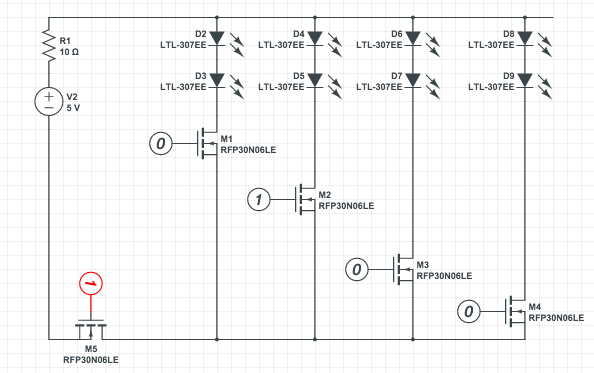Im trying to build a circuit to send information using IR led, using pulse signals my leds (TSAL6400) operates at 1.35V, and their maximum pulse current is rated 200mA
After struggling a bit with BJT transistors, and realizing that since I'll send the data using RPI (Gpio is 3.3V, 16mA), I switched to NMOS transistors. I found a local dealer with RFP30N06LE
Vgs(th)= 1-2V (min,max)
Rds(on)=0.047Ohm
My circuit (due to other limitations, and the fact I need to decide on which branch of leds to send the command on, each branch is a different room in my home)

As I demonstrated in this sketch, each of the branches represents a room, and I want to each time send a command to a specified room.
So, for instance, to send to the second branch from the left, I will turn the M2 on ("1" = 3.3V of my gpio at 16mA max), and will send the pulses by turning on and off M5
In order to reach 200mA I need a total voltage drop of 2.3V over my resistors and transistors.
If R1=11.5Ohm, for M1-M4: Vds=0V, Vgs=3.3V
Since Vds=0V will keep the transistor closed (no current flow), I assume I need to raise the voltage just a bit, but not sure how to make it appropriate for case with two transistors, one after the other.
If I will use Rtot=8.5Ohm + 1.5Ohm + 1.5Ohm, and placing R1 where it is already, R2=1.5Ohm before M5 and another one after. Is that the correct way?
This way:
Vgs(M2)=3V
Vds(M2)=0.3V
Vgs(M5)=3V
Vds(M5)=0.3V
Is that correct?
